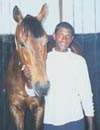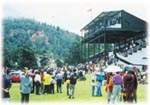Galloping
to glory
Text and pix by Hiranthi Fernando
The thunder of hooves and the excited screams of the spectators
filled the Nuwara  Eliya
race course as 'Ancient Warrior', 'Crowning Star', 'Nicodamus',
'Court of Appeal', 'Libo Queen', 'Turn to Gold', 'Avaglow' and
other impressively named thoroughbreds raced for glory in the
Governor's Cup. Eliya
race course as 'Ancient Warrior', 'Crowning Star', 'Nicodamus',
'Court of Appeal', 'Libo Queen', 'Turn to Gold', 'Avaglow' and
other impressively named thoroughbreds raced for glory in the
Governor's Cup.
Death
race
The sudden death of a horse competing in the Governor's
Cup cast a damper over the festive atmosphere of the New
Year race meet. Laktara, a five-year-old thoroughbred
from the Monaro stables collapsed and died soon after
completing the race. The owners of the horse, Mrs. Santha
de Zoysa and Mr. Ajantha de Zoysa said the death was due
to a heart attack.
Dr. Anil Pushpakumara, a Veterinary Surgeon from Peradeniya
University who was at the meet said death could have been
due to a heart attack or a rupture of a blood vessel.
He was unable to confirm this as a postmortem was not
done. Such unfortunate deaths, although rare, could occur
in horses due to excitement and exhaustion, he said.
|
Horse
racing, which had been in decline in Sri Lanka since the 1960s
is now being revived and last Sunday's races, the Nuwara Eliya
New Year Meet, one of the highlights of the 'season' drew
a colourful and enthusiastic crowd. Spectators turned up in
their numbers sporting stunning fashions, complete with fur-trimmed
umbrellas and feathered hats. (See also Ascot
in the hills )Prizes were awarded for the best-dressed
ladies, smartest and prettiest 'fillies' as well as for the
best hats. The Turf Club too looked its Sunday best with the
flower beds all ablaze with colour. After many years, much
to the organizers' satisfaction, the April horse races at
Nuwara Eliya seemed to be indeed regaining some of its lost
popularity.
The prestigious
'Governor's Cup', the main event of the day had a line-up
of ten beautiful horses, who walked smartly round the paddock,
glossy coats gleaming and heads held high. Another attraction
at the meet was the presence of the internationally known
jockeys from India and Ireland.
"We
have made many improvements during the past two years,"
said Bernard Halahackone, Chairman, Board of Stewards of the
Sri Lanka Turf Club. "This building is 111 years old.
We want to bring it back to what it was." Indeed, many
improvements could be seen. The broken railings around the
course had been replaced with new white painted railings and
overgrown trees and shrubs cleared so that spectators would
have a clear view of the entire course from the grandstand.
A sand track has  been
laid for the horses. been
laid for the horses.
The polythene-covered
carnation plots, however, remain an obstruction and eyesore.
"The cultivators have been given alternative land for
their flower projects but they have still not removed their
sheds and vacated the premises, despite representation to
the Municipal Council and the Minister," Mr. Halahackone
said. He explained that after the carnation stands are removed,
they would turf the centre of the course to give spectators
an unimpeded view.
At present
some 30 - 40 unemployed youth earn their living by providing
pony rides for children outside the course, as they are not
permitted inside the race course. Mr. Halahackone said they
planned to make two rings within the premises for the pony
rides to enable these boys to make a reasonable living. He
added that they intend to improve racing in Nuwara Eliya as
an added tourist attraction.
Tracing
the history of horse racing in the country, Mr. Halahackone
said the 37-acre Nuwara Eliya race course was originally taken
on a 99-year government lease, with the first signatory being
Sir Solomon Dias Bandaranaike.
Horse-racing
was at its height in the 1950s. After the 1960s there was
no thoroughbred racing for 10 to 15 years. When the import
duty on horses was raised, the sport died. With the reduction
of the import duty in 1978, interest in the sport was revived
and people once again began importing horses.
It was
through the efforts of the late Upali Wijewardene, then Chairman
of the Board of Stewards and Bernard Halahackone that thoroughbred
racing was reintroduced. Mr. Halahackone said his association
with the Nuwara Eliya race course goes back 62 years, for
aged just three, he had ridden a pony there. "My father
who had the best Arab horses in Sri Lanka, was a successful
private owner and trainer and good rider as well," he
reminisced.
There
are over 100 racehorses in the country now, thoroughbreds,
half-breeds and locally bred thoroughbreds. Next year, 30
locally bred thoroughbreds are expected to race at the meet.
Rajan
Sellamuttu, also a Steward of Turf Club started breeding horses
in 1987. Since then several other Turf Club members have done
the same. Mr. Sellamuttu owns the Argyle stud farm in Kotagala,
where he has about 30 locally bred and imported horses. "We
bought six to seven-year-old stallions from India and crossed
them with mares from Delft in Sri Lanka," he said. The
stallions cost around Rs.150,000 to Rs. 250,000. They also
had some Indian mares and have bred thoroughbred foals as
well as cross-bred foals. " It is an industry that creates
much employment for instance, horse keepers, trainers, farriers,
Turf Club employees," Mr. Sellamuttu said.
The coveted
'Governor's Cup' was won by Ancient Warrior, a thoroughbred
imported from India by Nigel Austin. In his spotlessly clean
and well-maintained stables at the Nuwara Eliya race course,
Mr. Austin has 12 imported thoroughbreds. The thoroughbred
is a special breed of horse, fast and most suited for racing,
evolved in England in the 17th and 18th centuries by crossing
imported Arab stallions with English running horses. Mr. Austin
however, does not breed horses but imports them from India.
"Eight
or nine years ago, there were some Australian horses coming
in to Sri Lanka," he said. "During the last three
or four years, the imports have been from India, where breeding
goes on in a big way."
Horses
over five years are sold to Sri Lankan importers. The Sri
Lankan horse owners have connections with trainers in India,
who recommend the horses offered for sale. His current winner,
'Ancient Warrior' was bought at six years. The price depends
on the horse, he said. With freight, the cost of importing
a horse is around Rs. 250,000 to Rs.300,000. As a commercial
enterprise, Mr. Austin said the Nuwara Eliya course would
not be viable unless it is a second course.
S.D. Lalith
who trains and maintains the horses in Austin's stables said
they have a staff of ten to look after the 12 horses and stables.
"We do daily track work with all the horses for half
an hour," Lalith said. Two to three weeks before the
races, the horses are given regular gallops in the trotting
ring or on the track to keep them in form. The horses are
brushed and groomed daily. Twice a day they are fed on oats,
mixed with horse feed, carrots and equine additions which
include vitamins, worm treatment and so on. These requirements
are imported from India and Australia.
This was
the second Governor's Cup win for the stables. In 1998, another
horse, 'Boomerang' clinched the trophy. Lalith himself an
experienced jockey, has ridden to victory in '93, '94, and
'95 on Sandy's Queen with another stable.
Five horse
racing meets were held in Nuwara Eliya during the April season.
Meets will also be held in August and December as the Sri
Lanka Turf Club strives to revive the sport of kings in Nuwara
Eliya to its past grandeur.
|